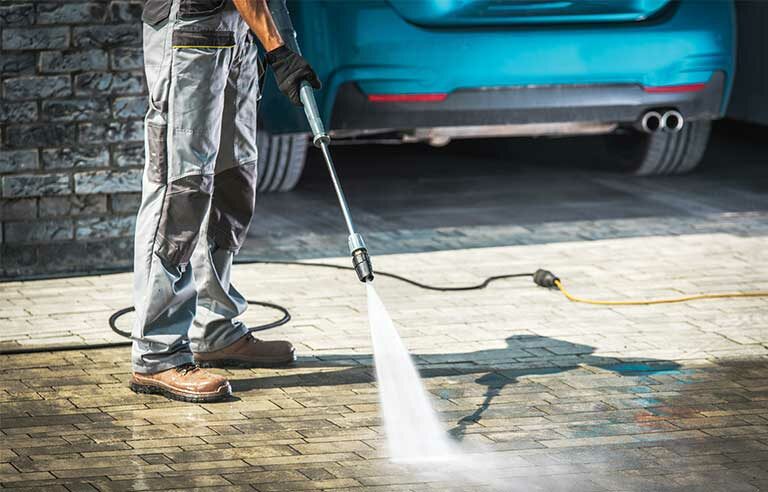
When most people think of power washing, they picture blasting grime off driveways or siding. But those aren’t the only places where dirt, algae, mold, and buildup collect. In fact, there are several commonly overlooked surfaces around your home or business that can benefit just as much — if not more — from a deep, pressurized clean. 💦
If you want to get the most out of your power washer or your next professional cleaning service, don’t stop at the obvious. Here are the 7 most neglected surfaces that could use a good power wash — and why they matter. 🧽⚡
1. 🏠 Fascia Boards and Soffits
You probably don’t pay much attention to the underside of your roof’s overhang — the soffits — or the trim along your roofline, called fascia. But over time, these areas collect dirt, spider webs, pollen, and mold, especially in shaded or damp environments.
Why it matters:
- Helps prevent mold buildup near your attic vents
- Keeps pests (like wasps and spiders) from nesting
- Makes your home look sharper and more cared for from the street
📌 Pro tip: Use a low-pressure setting or soft wash here to avoid water damage, especially if the area is near vents or wooden trim.
2. 🚪 Garage Doors
Your garage door is one of the first things people see from the street, yet it’s often skipped when power washing the exterior. Dust, exhaust residue, pollen, and even bird droppings can stain and discolor it over time.
Why it matters:
- Improves curb appeal instantly
- Reduces wear and tear on the finish
- Keeps track systems clean and functioning properly
🎨 If you plan to repaint or refinish your garage door, a pressure wash is a perfect first step.
3. 🪑 Outdoor Furniture
Your patio chairs and tables go through a lot: sun, rain, dust, food spills, bird mess, and more. Even though they’re built for the outdoors, they can get pretty grimy — especially if they’re stored under trees or near a garden.
Why it matters:
- Prolongs the life of your furniture
- Keeps your outdoor space guest-ready
- Removes allergens like pollen and mold spores
💡 Use a wide-angle nozzle and low pressure for wood or plastic to avoid splintering or warping.
4. 🧱 Retaining Walls and Hardscaping
Stone, brick, and block retaining walls add structure and beauty to your yard — but they also trap moisture, leaves, and dirt. Over time, they can look dull, discolored, or even grow moss.
Why it matters:
- Preserves structural integrity by preventing algae and root growth
- Enhances the look of flower beds and landscaping
- Removes slippery buildup that could be a fall hazard
🧽 These surfaces can usually handle higher pressure, but avoid cracked mortar or delicate edging.
5. 🌉 Pool Decks and Surrounding Areas
Pools are magnets for mold and mildew due to constant exposure to water and sun. The deck and walkways around them are especially vulnerable — and they can quickly become slippery and hazardous.
Why it matters:
- Improves safety by reducing slip risks
- Prevents staining from sunscreen, leaves, or algae
- Keeps the entire pool area looking clean and inviting
👣 Be extra careful with textured surfaces like stamped concrete — use medium pressure and rinse thoroughly.
6. 🌿 Fences
Whether it’s wood, vinyl, or metal, your fence is exposed to the elements year-round. It can develop a layer of dirt and mildew that you might not even notice until you compare it to a freshly washed section.
Why it matters:
- Prevents rot in wooden fences
- Restores original color and texture
- Prepares the surface for painting or staining
🪵 Soft washing is ideal for older wood, while newer vinyl or composite can handle moderate pressure.
7. 🌀 Trash Bin Areas and Side Yards
Out of sight doesn’t mean out of grime. Areas where you store your garbage bins or unused yard tools tend to collect grease, mildew, bugs, and unpleasant odors.
Why it matters:
- Improves hygiene and smell
- Discourages pests like ants and raccoons
- Makes side yards usable again
♻️ A good power wash in these areas goes a long way, especially with a degreasing detergent.
🌟 Bonus: What to Avoid Power Washing
While power washing is incredibly versatile, there are a few surfaces you should never hit with high pressure:
- Asphalt roofing shingles
- Old, cracked stucco
- Delicate outdoor electronics or lighting
- Lead paint surfaces
- Windows (use a soft rinse instead)
❗ When in doubt, test a small, hidden area first — or hire a pro to assess the job safely.
💡 Final Thoughts: Go Beyond the Basics
Power washing is more than just siding and driveways. By expanding your cleaning routine to include these commonly overlooked surfaces, you can:
- Boost your home’s appearance 🏡
- Protect valuable materials and structures 🔧
- Improve safety and hygiene 🧼
- Get more value from your power washing investment 💰
So next time you’re firing up the pressure washer, don’t stop at the obvious. Give these underappreciated areas a little love — and enjoy the kind of clean that turns heads. 😎



